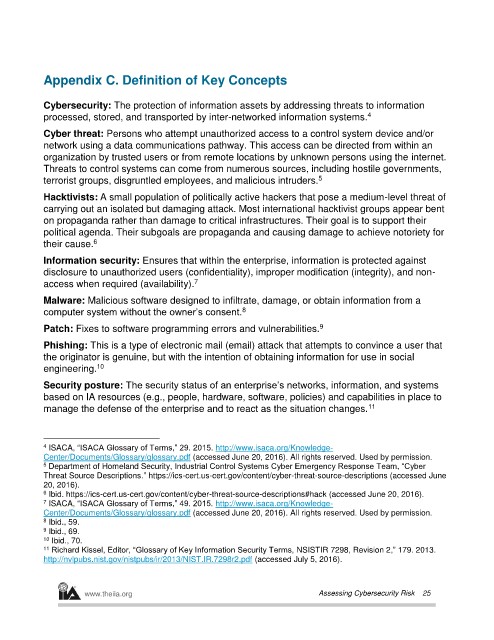Page 329 - ITGC_Audit Guides
P. 329
Appendix C. Definition of Key Concepts
Cybersecurity: The protection of information assets by addressing threats to information
4
processed, stored, and transported by inter-networked information systems.
Cyber threat: Persons who attempt unauthorized access to a control system device and/or
network using a data communications pathway. This access can be directed from within an
organization by trusted users or from remote locations by unknown persons using the internet.
Threats to control systems can come from numerous sources, including hostile governments,
5
terrorist groups, disgruntled employees, and malicious intruders.
Hacktivists: A small population of politically active hackers that pose a medium-level threat of
carrying out an isolated but damaging attack. Most international hacktivist groups appear bent
on propaganda rather than damage to critical infrastructures. Their goal is to support their
political agenda. Their subgoals are propaganda and causing damage to achieve notoriety for
6
their cause.
Information security: Ensures that within the enterprise, information is protected against
disclosure to unauthorized users (confidentiality), improper modification (integrity), and non-
access when required (availability).
7
Malware: Malicious software designed to infiltrate, damage, or obtain information from a
8
computer system without the owner’s consent.
9
Patch: Fixes to software programming errors and vulnerabilities.
Phishing: This is a type of electronic mail (email) attack that attempts to convince a user that
the originator is genuine, but with the intention of obtaining information for use in social
10
engineering.
Security posture: The security status of an enterprise’s networks, information, and systems
based on IA resources (e.g., people, hardware, software, policies) and capabilities in place to
11
manage the defense of the enterprise and to react as the situation changes.
4 ISACA, “ISACA Glossary of Terms,” 29. 2015. http://www.isaca.org/Knowledge-
Center/Documents/Glossary/glossary.pdf (accessed June 20, 2016). All rights reserved. Used by permission.
5 Department of Homeland Security, Industrial Control Systems Cyber Emergency Response Team, “Cyber
Threat Source Descriptions.” https://ics-cert.us-cert.gov/content/cyber-threat-source-descriptions (accessed June
20, 2016).
6 Ibid. https://ics-cert.us-cert.gov/content/cyber-threat-source-descriptions#hack (accessed June 20, 2016).
7 ISACA, “ISACA Glossary of Terms,” 49. 2015. http://www.isaca.org/Knowledge-
Center/Documents/Glossary/glossary.pdf (accessed June 20, 2016). All rights reserved. Used by permission.
8 Ibid., 59.
9 Ibid., 69.
10 Ibid., 70.
11 Richard Kissel, Editor, “Glossary of Key Information Security Terms, NSISTIR 7298, Revision 2,” 179. 2013.
http://nvlpubs.nist.gov/nistpubs/ir/2013/NIST.IR.7298r2.pdf (accessed July 5, 2016).
www.theiia.org Assessing Cybersecurity Risk 25

